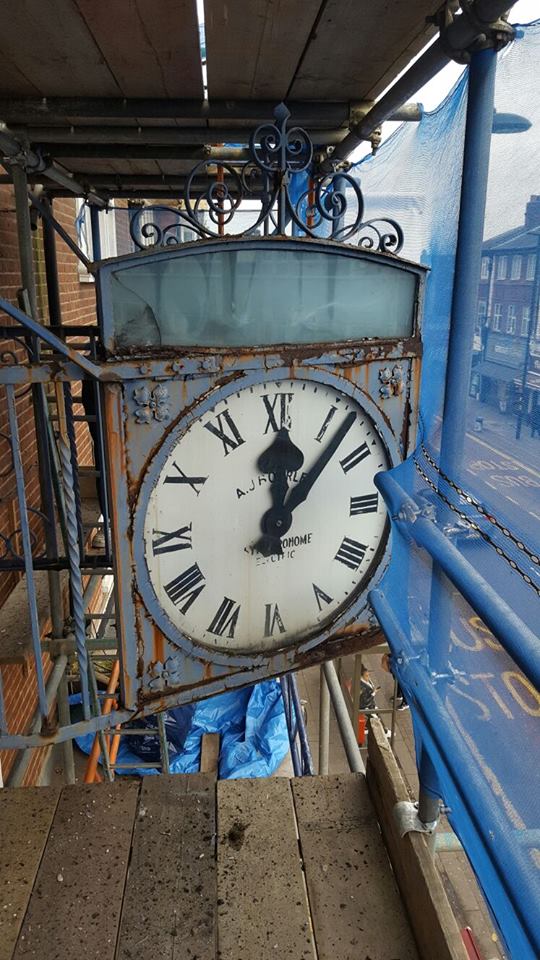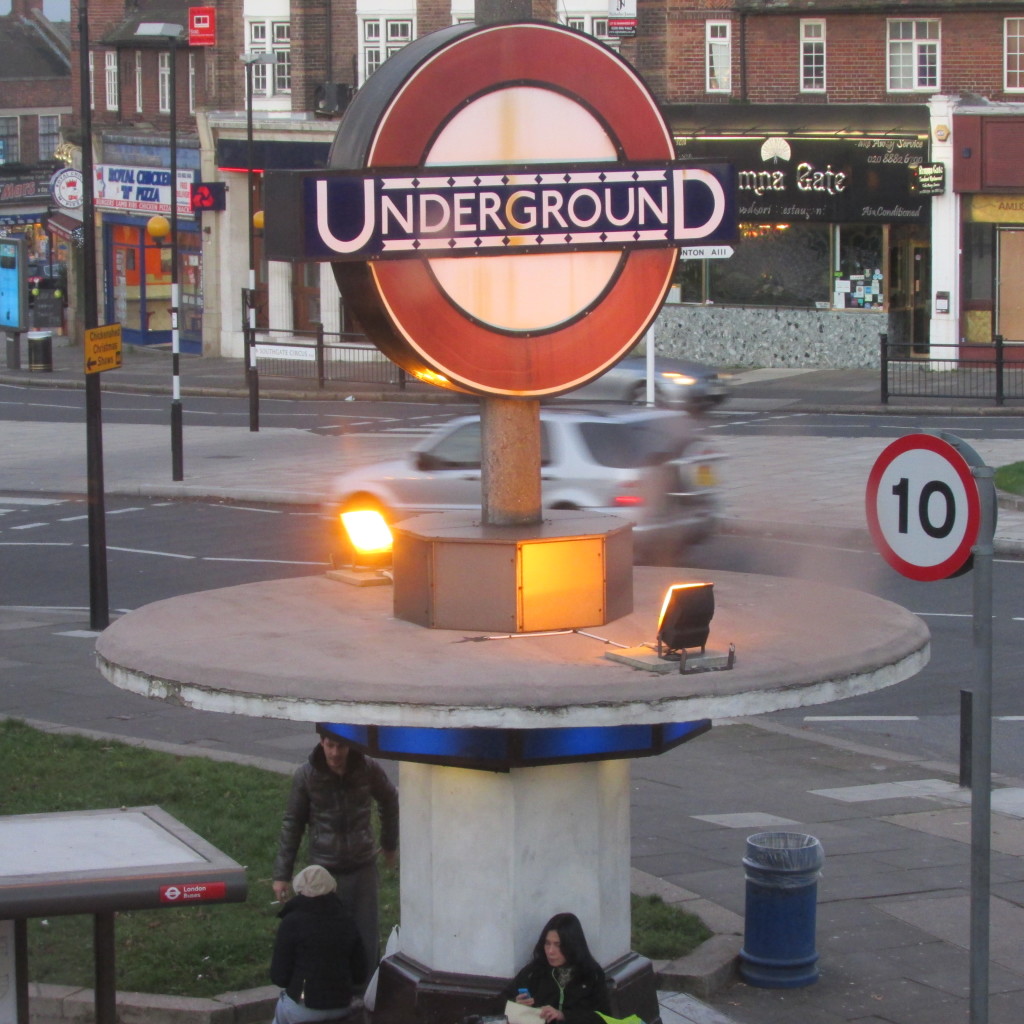This image was kindly provided by Erol Mehmet, who asked a friend who is currently working on renovations of the building above the Costa Coffee shop to take a picture while he was on the scaffolding. I love this photo, but as Erol says, the clock is in urgent need of TLC before we lose it altogether.
I originally published this article in 2014, but I think it bears repeating, especially, if Sir Geoffrey honours the tradition and makes his once-every- six-year reappearance this Christmas…
If you have a few hours to spare this Sunday you could do worse than wander up to Southgate, sit for a few moments on the tube or bus to Cockfosters, and take a wander around the beautiful undulating and Repton designed grounds of Trent Park, once part of the Royal Hunting Forests of Enfield Chase. Head past the café on the path that goes north of the lake and you will eventually come to the mysterious green waters of Camlet Moat, a scheduled ancient monument.
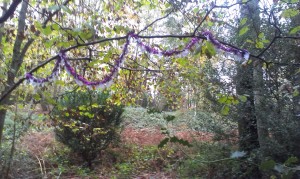
It may be centuries old but the C shaped enclosure, full of ancient trees, has a kind of unknowable life of its own, with letters carved into trees, charms and tokens wedged and tied into the branches, and tinsel and streamers laid over the limbs of the ancient trees. Druids say that it’s a spiritual place, where one can experience the earth’s energy. It’s certainly eerie as the low winter sun slowly sinks and the shadows grow longer, a place where anything might happen.
But our story begins, not in Enfield, but in Egypt in 1923 when manicured socialite Sir Philip Sassoon was invited by Lord Carnarvon and Harold Carter to witness the opening of the tomb of Tutankhamun. Returning home, unaffected by the famous curse of King Tut but excited by the prospect of hidden treasure, Sassoon’s thoughts turned to the ancient monument on his own property, Trent Park, where he regularly entertained the likes of Charlie Chaplin, Rex Whistler, and George Bernard Shaw in tasteful opulence. Before many months had passed, Sassoon’s team had started to dig.
Camlet had for some centuries been reputed to have been the home of Sir Geoffrey Mandeville, the first Earl of Essex and Constable of the Tower of London, though some say it was first the home of King Arthur. In ancient times it was right at the centre of the Royal Forest: the moat made it capable of defence, and so Camlet was ideally placed to manage and police the forest. The earliest records show that permission was granted to crenelate an existing house on the site in 1347, but that the house was demolished 100 years later so that the materials could be sold to pay for renovations to Hertford Castle.
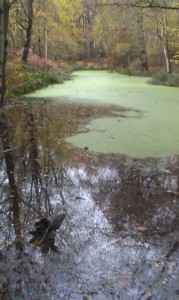
And so, Sassoon drained the moat while the locals watched and waited.
Within a little while, the remains of a huge drawbridge were found, and a long wall, in some places 5 feet thick, plus Roman sandals, ancient daggers and horseshoes. Remarkable though these finds were, press reports soon began to focus not so much on the finds, but of the risk of disturbing the ghost of Sir Geoffrey Mandeville, who, as legend had variously described it, had buried treasure under the paved bottom of a well on the site to keep it from his many enemies or alternatively had fallen in with his treasure and drowned, his spirit lingering to ensure its eternal protection. The remains of an ancient well were indeed found, in the north east corner of the area enclosed by the moat.
Well might the naysayers have worried.
There were no sightings during this excavations, but this may have been because Geoffrey had apparently forgotten about his treasure – perhaps his hard currency was no good in the spirit world – and flounced off. According to a local writer calling himself the Philanderer, he had moved to East Barnet, first to a stable, which was unfortunately then pulled down by the council, and then to the house of Nora O Callahan and her sister, where he set to terrorising them by knocking on the door, thumping around, rattling their letterbox and generally terrifying their normally fearless dog. Next, he was seen by persons unrecorded, in full regalia of red cloak and spurs.
The national press descended, and by all accounts, Barnet became a place of ghost hunting bedlam and police had to be brought in to regulate the traffic. One William Stutters complained of the racket that Sir Geoffrey was making and warned that local building work was waking the dead. Paranormal activity was now also bedeviling the building which is today the Prince of Wales pub. Curiously though, by 1930 the Philanderer was saying that Sir Geoffrey was back stalking around Cockfosters at Christmas time though in December 1932 he was seen in full armour in East Barnet by the members of the local psychic research society, which was lucky, because they just happened to be staking the place out at midnight. By this time, it was being said that Sir Geoffrey made an appearance on Christmas Eve every six years.
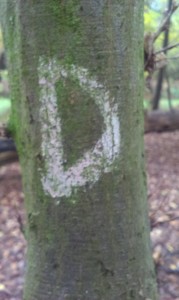
Sightings of Sir Geoffrey have continued intermittently, though they haven’t occurred at 6 year intervals as specified or even in the same place – he has been spotted in Hadley Woods and at East Barnet church. If the legend is correct, he is next due to appear at Christmas in 2016. Who knows where he will have moved to by then?
If your interest is piqued by the story of Sir Geoffrey, do read Jennie Lee Cobban’s brilliant, hilarious and entertaining Geoffrey de Mandeville and London’s Camelot. Currently out of print but available in libraries.*
This article originally appeared in the December 14 issue of Palmers Green and Southgate Life
*Addendum – new edition available at Barnet museum.
From Blockbuster to chicken shack?
There are rumours, unsubstantiated as far 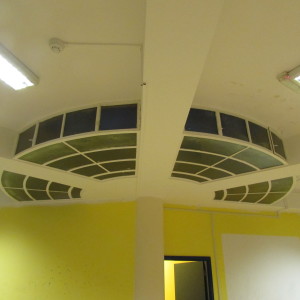 as I know, that the former Blockbusters building in Southgate may be about to become a Nandos.
as I know, that the former Blockbusters building in Southgate may be about to become a Nandos.
The building dates from the early 1930s, as part of the extensive complex of Charles Holden’s arte moderne style Southgate Station.
Despite my sneaking regard for the odd snack in Nando’s, it’s a wonderful building and it is a shame that there is no community use for it on the cards.
Right now the space is empty and it’s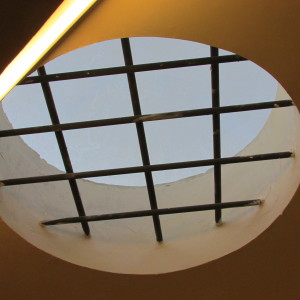 a real treat to be able to see its simple beauty uncluttered – if you are passing, take a look inside.
a real treat to be able to see its simple beauty uncluttered – if you are passing, take a look inside.
But if you can’t get there soon, here are some pictures I took when London Underground kindly gave permission for the building to host a temporary exhibition by the local creative collective, Creative Exchange (thanks for inviting me an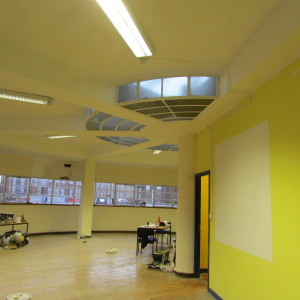 d my camera in, Dan Maier)
d my camera in, Dan Maier)
Though over 80 years old, it still feels spacy, optmistic, unreal, and the views outside just a tiny bit Flash Gordon (by which I mean the original one that the BBC used to show in the school holidays!).
When Bowie came to Palmers Green
Some of you will have seen this story before but following the sad death of one of British music’s true influencers, here is my article about the time he came to Palmers Green.
In November 1968, a 21 year old David Bowie appeared at the Intimate Theatre Palmers Green in a mime improv production called Pierrot in Turquoise.
At the time Bowie had only released one  album as a solo artist and was still 8 months away from the breakthrough single Space Oddity. (Laughing Gnome had been released in 1967, but would not be a hit until 1973).
album as a solo artist and was still 8 months away from the breakthrough single Space Oddity. (Laughing Gnome had been released in 1967, but would not be a hit until 1973).
Devised by dancer and coreographer Lindsay Kemp, who was to radically influence Bowie’s approach to performance, the five songs featured in the production were all written by Bowie. The four nights at Palmers Green appear to have been the last time the production was performed live. However, the production was filmed in 1970 by Scottish TV as Pierrot in Turquoise/The Looking Glass Murders.
The website IMDb.com gives the plot synopsis of the TV version thus
“Pierrot is a freaky mime who ventures into a mirror where he falls in love and rolls around with the equally grotesque Columbine. But when Columbine beds black stallion (in half-assless spandex) Harlequin, Pierrot’s jealousy takes over and drives him to murder. Cloud (Bowie) watches over the proceedings from his perch (on a ladder!) and narrates in song.”
Comments IMDB contributor Vinnie Rattolle:
“Weird” doesn’t begin to describe this one. It begins and ends with a man playing piano, but no sound is emitted. The sparse production doesn’t betray its theatrical roots — there’s a grand total of two sets and they make no attempt to disguise the fact they’re thrown together on stages. While I’ve never found mimes as unsettling as most, the trio in this film are REALLY creepy. And although it has a short running time of 26 minutes, it’s so tediously strange and surreal that it felt like it was three hours long.”
Judge for yourself! You can view a clip here.
Did you see Pierrot in Turquoise in Palmers Green? Tell us more!
For further information about David Bowie’s early performances, visit http://www.bowiewonderworld.com/tours/tour58.htm
The Triangle Palmers Green in 1965
No railings, hardly any cars and our beautiful tree …

If you fancy a modest little outing this weekend, wait for a break in the weather and put on a hat and coat. Turn left from Green Lanes at the Fox and then cross the road, passing under the majestic holly arch and into Pellipar Close. Walk right to the end to the railings and look for the roof of an outbuilding in the well-kept gardens of Skinners Court.
Then, stand on tip toe. There, through the vegetation, you might just catch a glimpse of one of the oldest things in Palmers Green: two weather-beaten figures in stone, a man and a woman, the man with a crutch looking out imploringly, the woman also of straitened circumstances, perhaps barefoot. The figures didn’t start their life in Palmers Green – but they have spent their last one hundred years here.
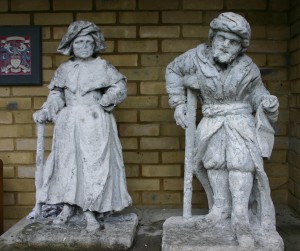
Their original home was at the Skinners Almshouses which once stood 8 miles away in London’s East End. The first Skinners Almshouses, at St Helen’s Mile End were set up for the accommodation of six freemen of the Skinners Company, following a bequest in the will of Sir Andrew Judd in 1551. In 1683 the will of Lewis Newbery made further provision for twelve Skinners widows as long as they did not remarry.
Though often depicted as picturesque in contemporary pictures, the Mile End almshouses were modest, laid out as two rows of cottages, the doors of which gave onto a single room but with extensive gardens behind. The occupants were given a small pension, including an allowance for coal, and were expected to attend prayers twice a day.
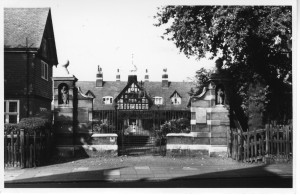
And so it continued for two hundred years until the land was sold in 1895. New land had already been purchased in Palmers Green on the site of a farm owned by a Mr Graves, and new almshouses, designed in a simple yet graceful art and crafts style, took shape. The buildings were on three sides around a garden which faced onto Green Lanes, and in pride of position, set into pillars at the gate, were two figures which had adorned the Mile End site – the same figures you can still see in the gardens today. Alan Dumayne in his book Once upon a time in Palmers Green recalls that the old almshouses were a peaceful spot and the gardens a suntrap. Residents could often be seen sitting outside on deckchairs on a fine day.
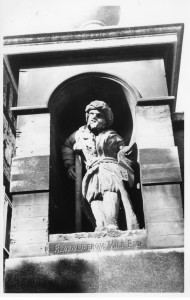
Sadly the new building was only to last 70 years. It was destroyed by fire in 1966 and half the plot, that nearest Green Lanes, was developed into flats, separated from the new Skinners Court by Pellipar Close (Pellipar being a reminder of the old name of those who earned their living from the getting, fashioning and selling of furs). Incidentally, the site occupied by the flats was part of old Palmers Green’s original green.
The new Skinners Court is a modern, inviting building, with lovely gardens and a friendly demeanour. It still provides shelter for the retired, but not necessarily the destitute. But the two figures remain as a reminder of what destitution once meant.
- This article has been prepared as part of the process to nominate buildings and landmarks to Enfield’s updated local list. For more information see http://www.palmersgreenn13.com/2015/09/11/every-street-in-palmers-green/. If you have any suggestions for buildings which aren’t listed but should be included in the local list, I’m afraid it’s too late as today is the deadline, but I have, you know, been asking yer…
